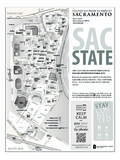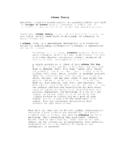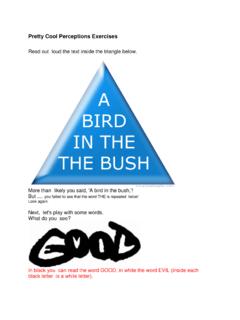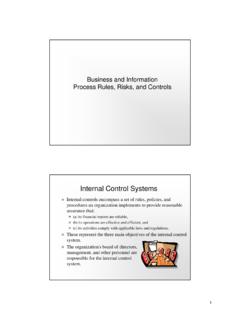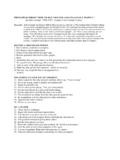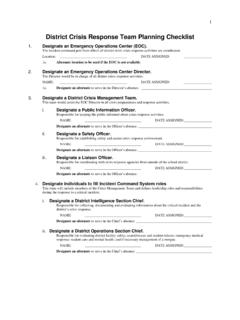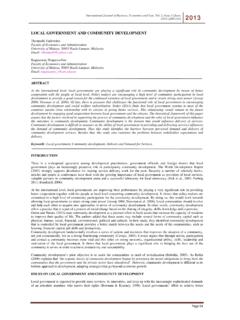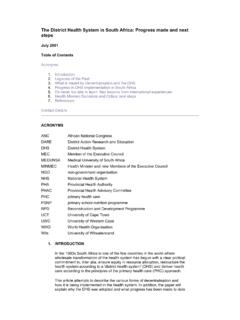Transcription of The New Public Service: Serving Rather than Steering
1 The New Public Service: Serving Rather than Steering 549 Robert B. DenhardtJanet Vinzant DenhardtArizona State UniversityThe New Public Service: Serving Rather than SteeringThe New Public Management has championed a vision of Public managers as the entrepre-neurs of a new, leaner, and increasingly privatized government, emulating not only the prac-tices but also the values of business. Proponents of the New Public Management have devel-oped their arguments largely through contrasts with the old Public administration . In this com-parison, the New Public Management will, of course, always win. We argue here that thebetter contrast is with what we call the New Public Service, a movement built on work indemocratic citizenship, community and civil society, and organizational humanism and dis-course theory. We suggest seven principles of the New Public Service, most notably that theprimary role of the Public servant is to help citizens articulate and meet their shared interestsrather than to attempt to control or steer management has undergone a revolution.
2 Ratherthan focusing on controlling bureaucracies and deliveringservices, Public administrators are responding to admon-ishments to steer Rather than row, and to be the entrepre-neurs of a new, leaner, and increasingly privatized govern-ment. As a result, a number of highly positive changes havebeen implemented in the Public sector (Osborne and Gaebler1992; Osborne and Plastrik 1997; Kettl 1993; Kettl andDiIulio 1995; Kettl and Milward 1996; Lynn 1996). But asthe field of Public administration has increasingly abandonedthe idea of rowing and has accepted responsibility for steer-ing, has it simply traded one adminicentric view for an-other? Osborne and Gaebler write, those who steer the boathave far more power over its destination than those whorow it (1992, 32). If that is the case, the shift from rowingto Steering not only may have left administrators in chargeof the boat choosing its goals and directions and chartinga path to achieve them it may have given them more powerto do our rush to steer, are we forgetting who owns theboat?
3 In their recent book, Government Is Us (1998), Kingand Stivers remind us of the obvious answer: The govern-ment belongs to its citizens (see also Box 1998; Cooper1991; King, Feltey, and O Neill 1998; Stivers 1994a,b;Thomas 1995). Accordingly, Public administrators shouldfocus on their responsibility to serve and empower citi-zens as they manage Public organizations and implementpublic policy. In other words, with citizens at the forefront,the emphasis should not be placed on either Steering orrowing the governmental boat, but Rather on building pub-lic institutions marked by integrity and B. Denhardt is a professor in the School of Public Affairs at ArizonaState University and a visiting scholar at the University of Delaware. is a past president of the American Society for Public Administra-tion, and the founder and first chair of ASPA s National Campaign for PublicService, an effort to assert the dignity and worth of Public service across thenation.
4 He is also a member of the National Academy of Public Administra-tion and a fellow of the Canadian Centre for Management Development. has published 14 books, including Theories of Public Organiza-tion, Public administration : An Action Orientation, In the Shadow of Orga-nization, The Pursuit of Significance, Executive Leadership in the Public Ser-vice, and The Revitalization of the Public Service. He holds a doctorate fromthe University of Kentucky. Email: Vinzant Denhardt is a professor in the School of Public Affairs at Ari-zona State University. Her teaching and research interests lie primarily in or-ganization theory and organizational behavior. Her book (with Lane Crothers),Street-Level Leadership: Discretion and Legitimacy in Front-Line Public Service,was recently published by the Georgetown University Press. In addition, has published numerous articles in journals such as Administrationand Society, American Review of Public administration , Public Productivityand Management Review, and Public administration Theory and Praxis.
5 Priorto joining the faculty at Arizona State, Dr. Denhardt taught at Eastern Wash-ington University and served in a variety of administrative and consulting po-sitions. She holds a doctorate from the University of Southern California. Public administration Review November/December 2000, Vol. 60, No. 6 BackgroundAs it is used here, the New Public Management re-fers to a cluster of ideas and practices (including reinven-tion and neomanagerialism) that seek, at their core, to useprivate-sector and business approaches in the Public sec-tor. While there have long been calls to run governmentlike a business, the contemporary version of this debatein this country was sparked in the 1990s by PresidentClinton s and Vice President Gore s initiative to makegovernment work better and cost less. Modeled after con-cepts and ideas promoted in Osborne and Gaebler s 1992book Reinventing Government (as well as managerialistefforts in a variety of other countries, especially Great Brit-ain and New Zealand), the Clinton administration cham-pioned a variety of reforms and projects under the mantleof the National Performance Review.
6 In part, what has dis-tinguished these reforms and similar efforts at the stateand local level, from older versions of the run-government-like-a-business movement is that they involve more thanjust using the techniques of business. Rather , the New Pub-lic Management has become a normative model, one sig-naling a profound shift in how we think about the role ofpublic administrators, the nature of the profession, and howand why we do what we many scholars and practitioners have continued toexpress concerns about the New Public Management andthe role for Public managers this model suggests. For ex-ample, in a recent Public administration Review sympo-sium on leadership, democracy , and Public management,a number of authors thoughtfully considered the opportu-nities and challenges presented by the New Public Man-agement. Those challenging the New Public Managementin the symposium and elsewhere ask questions about theinherent contradictions in the movement (Fox 1996), thevalues promoted by it (deLeon and Denhardt 2000;Frederickson 1996; Schachter 1997); the tensions betweenthe emphasis on decentralization promoted in the marketmodel and the need for coordination in the Public sector(Peters and Savoie 1996); the implied roles and relation-ships of the executive and legislative branches (Carroll andLynn 1996); and the implications of the privatization move-ment for democratic values and the Public interest (McCabeand Vinzant 1999).
7 Others have suggested that Public en-trepreneurship and what Terry (1993, 1998) has called neomanagerialism threaten to undermine democratic andconstitutional values such as fairness, justice, representa-tion, and would like to suggest that, beyond these separatecritiques, what is missing is a set of organizing principlesfor an alternative to the New Public Management. We re-ject the notion that the reinvented, market-oriented NewPublic Management should only be compared to the oldpublic administration , which, despite its many importantcontributions, has come to be seen as synonymous withbureaucracy, hierarchy, and control. If that is the compari-son, the New Public Management will always win. Wewould like to suggest instead that the New Public Man-agement should be contrasted with what we term the NewPublic Service, a set of ideas about the role of Public ad-ministration in the governance system that places citizensat the there have been many challenges to the NewPublic Management and many alternative ideas promi-nently advanced by scholars and practitioners, there havebeen no attempts to organize these efforts and underscoretheir common themes.
8 This article is an effort to do , it briefly summarizes the foundations and major ar-guments of the new Public management as it contrasts withthe old Public administration . It then describes an alterna-tive normative model we call the New Public Service. This new model further clarifies the debate by suggestingnew ways of thinking about the strengths and weaknessesof all three approaches. We conclude by considering theimplications of placing citizens, citizenship, and the pub-lic interest at the forefront of a New Public New Public Management and theOld Public AdministrationOver the past decade and a half, the New Public Man-agement (again, including the reinvention movement andthe new managerialism) has literally swept the nation andthe world. The common theme in the myriad applicationsof these ideas has been the use of market mechanisms andterminology, in which the relationship between Public agen-cies and their customers is understood as based on self-interest, involving transactions similar to those occurringin the marketplace.
9 Public managers are urged to steer,not row their organizations, and they are challenged tofind new and innovative ways to achieve results or to priva-tize functions previously provided by the past two decades, many Public jurisdictions andagencies have initiated efforts to increase productivityand to find alternative service-delivery mechanisms basedon Public -choice assumptions and perspectives. Publicmanagers have concentrated on accountability and highperformance and have sought to restructure bureaucraticagencies, redefine organizational missions, streamlineagency processes, and decentralize decision making. Inmany cases, governments and government agencies havesucceeded in privatizing previously Public functions,holding top executives accountable for performance goals,establishing new processes for measuring productivityand effectiveness, and reengineering departmental sys-tems to reflect a strengthened commitment to account-The New Public Service: Serving Rather than Steering 551ability (Aristigueta 1999; Barzelay 1992; Boston et ; Kearns 1996).
10 The effectiveness of this reformagenda in the United States, as well as in a number ofother countries, has put governments around the worldon notice that new standards are being sought and newroles ideas were crystallized and popularized byOsborne and Gaebler s book, Reinventing Government(1992; see also Osborne and Plastrik 1997). Osborne andGaebler provided a number of now-familiar principlesthrough which Public entrepreneurs might bring aboutmassive governmental reform ideas that remain at thecore of the New Public Management. Osborne and Gaeblerintended these principles to serve as a new conceptual ornormative framework for Public administration , an ana-lytical checklist to transform the actions of government: What we are describing is nothing less than a shift in thebasic model of governance used in America.
